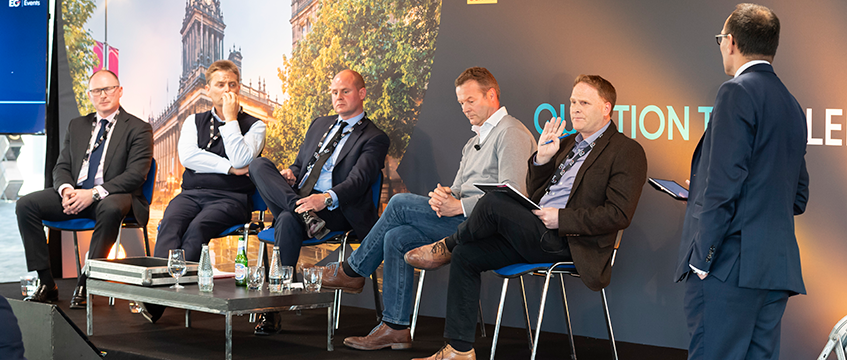In a retail market that has never been tougher and a residential environment that is seeing wholesale change, Leeds needs to focus on delivering good value to office tenants, improving transport infrastructure and embracing change.
A 200-strong audience at last week’s EG Leeds Question Time – which took place at MEPC’s Wellington Place – heard a panel of investors and advisers set out a vision to keep the city competitive.
Paul Pavia, head of development at MEPC, said his business was confident enough in the city’s office market to push beyond the scheme’s existing three buildings.
“It feels like we’ve still got plenty of energy there in the market,” he said. “Both we and our investors see a lot of steam still there. Our expectations are that we will deliver number four in 2020 and that it will still be a strong market.
“We’ve got 3,500 people here today and in three years’ time we’ll have 8,000 people. Three years after that we’ll have 13,500 people in this area.”
But Pavia warned that developers shouldn’t chase short-term rental growth over long-term sustainability.
“Leeds is a really affordable city,” he said. “We’ve got to stay that way in terms of the cost of living and the cost of rents. I know we want to push rents up and we need money, but there’s a tipping point where you start to race up against the likes of Manchester and Birmingham and you lose a competitive edge when you’re trying to attract people through north shoring.
See also: Future of Leeds rests on devolution deal
“What we have here is a great city and we need to build great buildings and then give tenants great value.”
Robin Dobson, head of retail development Hammerson, acknowledged that the national retail market was challenged, but said stronger cities would flourish.
“Has it ever been tougher? No it hasn’t. It’s a combination of things. So if you’re a retailer or an F&B operator, it’s a mixture of rates increases, changes in European raw materials coming in, which is obviously Brexit related, but it’s also the advance of online.”
Hammerson’s 575,000 sq ft Victoria Leeds scheme – comprising the Grade II-listed Victoria Quarter and newly developed Victoria Gate – opened in 2016. “We are firmly of the belief that the best locations and the best cities – and Leeds is a ‘best city’ – will continue to perform and outperform,” said Dobson. “To me, this is the nature of retail. It is continually changing. It keeps us sharp. It keeps us focused. But without question the prime in retail is becoming primer.”
Savills’ director of UK investment, Simon Lister, said he saw a “fairly steady period of continued investment” in the city which, according to Shoosmiths real estate partner Richard Outhwaite, would only grow if the city “shouted louder”.
The promise of HS3
Transport infrastructure would unlock further interest, according to Lister. “A lot of people are very dismissive about HS2, saying it’s 15 years down the line, but you’ve got to start believing in it and tell the story now because you’ll make some long-term investment decisions on the back of it.”
Outhwaite warned against choosing between HS2 and HS3. “We need them both and I think that the combined system will really enable connectivity.”
For Rick de Blaby, executive deputy chairman of Get Living, demographic changes in Leeds are symptomatic of wider changes in the real estate market. The business is planning a £180m, 756-home build-to-rent development on Globe Road on the South Bank of Leeds, and de Blaby said: “Property operators have to be much more engaged and about providing experience. We have to give the power to the customer – the resident – now. It’s not a landlord-tenant feudal thing anymore.
“There’s big shifts going on in real estate that are exciting and they make us all work harder. And you’re in much lower returns than you’ve been in the past. But it’s about time to be honest, about time the real estate sector grew up and delivered a product and a service and an experience that you could compare to lots of other sectors.”
Dobson said the future would be characterised by developers considering a mixed-use offer. “It isn’t just pure retail. It isn’t just pure commercial. It’s a fully integrated model. All the developments that we have and we will bring forward over the next 10 years have high proportions of PRS, as well as more leisure, more F&B and, toned down, definitely retail.”
Look to Birmingham
To make this approach successful in Leeds, said Dobson, the city should look not to Manchester but to Birmingham where transport connections have seen massive improvements.
“What used to be Birmingham New Street was the back door to the city [and what is now Grand Central] has suddenly become the front door to the city. There needs to be a deliverable infrastructure plan around how the station is the entrance gateway to Leeds and the Leeds region.”
And he said investment in transport directly drove wider investment in cities.
“In Birmingham we are also bringing forward the planning application for the Martineau Galleries, which is effectively a mixed-use commercial scheme around HS2. What’s interesting is the delivery of that is 2025-26. And the amount of interest that’s going on in Birmingham is on the basis that HS2 – we all hope and believe – will arrive in the next five to seven years.
“Infrastructure is by its name long term. The difficulty for Leeds is that the promise of HS2 is beyond most people’s perspective. But ultimately it has got to be good for Leeds.”
To send feedback, e-mail damian.wild@egi.co.uk or tweet @DamianWild or @estatesgazette











